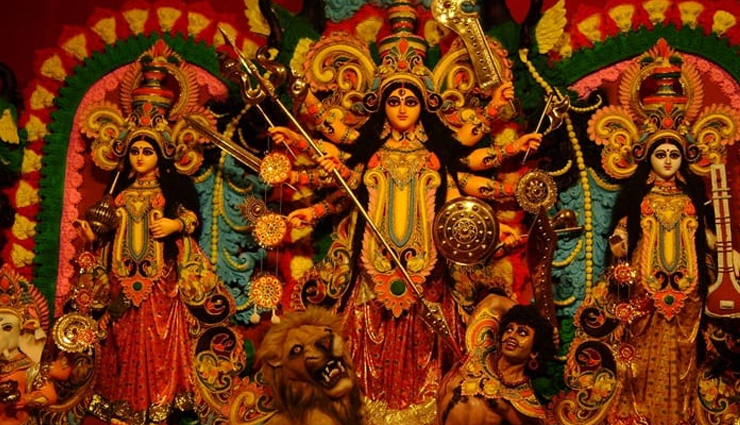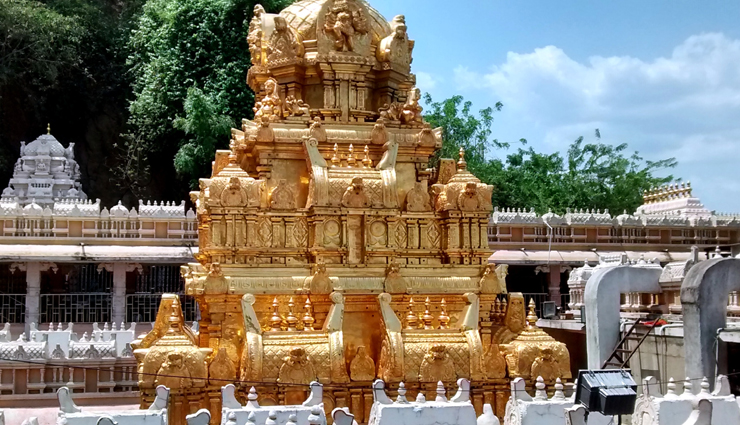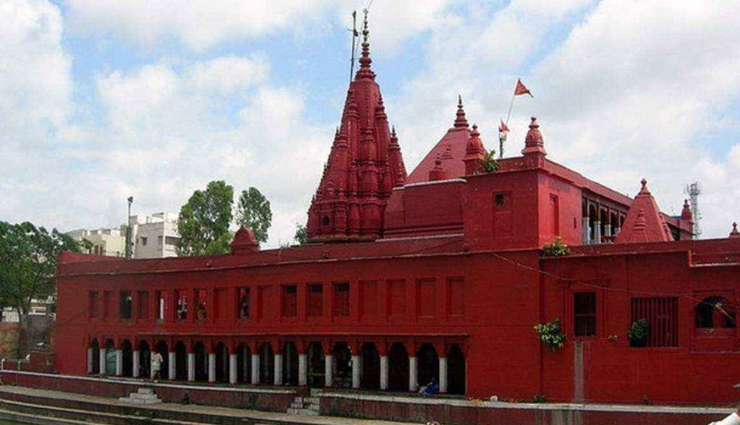15 Most Popular Maa Durga Temples To Visit In India
By: Priyanka Maheshwari Sun, 18 Oct 2020 08:16:53

Goddess Durga is considered the root cause of creation, preservation and annihilation. A pure form of Power ‘Shakti’, she is the manifested as the protector of the universe. An important and integral part of the Hindu faith, Goddess Durga is worshipped in her different forms across the country. The Goddess recognized as the supreme soul is prayed to in order to attain strength and fulfilment of wishes. From the northern states to the southern tip, her aura is extended in a manner that is incomprehensible. Across the country several temples of the Goddess can be seen and amongst them are some that have more value than the others. These temples are either in the form of Shaktipeethas or have an important legend attached to it.

* Vaishno Devi Temple, Jammu & Kashmir
Vaishno Devi is the most popular Durga temple in India. It is nestled amidst the Trikuta Mountain, which is 61 kilometres north of Jammu at an altitude of 1584m above the sea level. As far as the legend goes Vaishno Devi was devotee of Lord Vishnu, thus she practiced celibacy. However, Bhairo Nath- who was a tantric chased the Goddess and to the Trikuta Mountain. In order to save herself from Bhairo Nath, the Goddess took refuge in the cave and the Demon God could not find her for nearly 9 months. Vaishno Devi then taking the form of Kali cut off the head of Bhairo Nath. The cave where the Goddess hid is now a popular pilgrimage and is called as Garbha Joon. Vaishno Devi is accessible all through the year; however winter months are comparatively difficult for the visit.
* Mansa Devi Temple, Uttarakhand
Mansa Devi temple is situated in Badi Lambore (Lambore Dham) village on Sadulpur-Malsisar-Jhunjhunu road near Haridwar. The Mansa Devi temple got its name from the belief that the Goddess fulfils all the wishes of her devotees. The legend behind the temple is that the Goddess appeared in the dream of Seth Surajmalji, the head of Hamirwasiya family and asked him to build a temple. Surajmalji did as he was directed and gave the responsibility of the construction of the temple to his son. The temple was completed by 1975.

* Chamunda Devi Temple, Himachal Pradesh
Situated on the banks of the River Baner, Chamunda Devi Temple is yet another important Durga temple in India. The sacred shrine is located a few kilometres from Palampur and has the deity in the wrathful form. Devotees who have faith in the Goddess offer prayers here for their ancestors. It is said that in the olden days, people sacrificed themselves to the Goddess as well. One can also find a beautiful pond inside the temple, which is believed to have sacred water.
* Kamakhya Temple, Assam
One of the best known temples of Guwahati is Kamakhya, situated on Nilachal Hill at a distance of about 8kms west of the city. This temple honour Goddess Kamakhya, who is believed to be the essence of female energy. Kamakhya Temple is one of the 108 Shakti Peethas of Goddess Durga. As far as the legend goes, Kamakhya came into existence when Lord Shiva was carrying the corpse of his wife Sati, and her Yoni (female genitalia) fell to the ground at the spot where the temple now stands. The temple is in the natural cave that houses a spring. Down the flight of stairs to the bowel of earth, a dark chamber is located in the temple. Here is where the Matra Yoni or the part of Sati is believed to be draped in a silk sari and covered with flowers is kept. Kamakhya is known as an important temple for the Tantric sect, the shrine comes to life during the Ambubachi Fair and the Durga Puja.

* Amba Mata Temple, Gujarat
A highly revered pilgrimage that attracts pilgrims from all over the country, Amba Mata Temple is situated in Junagadh, Gujarat. It is one of the most picturesque towns in India and is dotted with monuments and religious places. The town situated at the base of the holy Girnar mountain making it an interesting place to visit in gujarat.
* Dakshineswar Kali Mandir, Kolkata
Situated along the Vivekananda Bridge north of Kolkata, Dakshineswar Kali Temple is famous for its association with Ramkrishna who is believed to have achieved spiritual vision here. This temple is said to be built by Rani Rashmoni in the year 1847. Ramakrishna once served as the temple’s head priest here. It is believed that while worshiping in front of the statue of Kali, Ramakrishna would fall to the ground and immersed in spiritual trance, lose all consciousness of the external world. It is how he achieved the spiritual vision here. The 12- spired temple has an enormous courtyard and is surrounded by 12 other temples that are dedicated to Lord Shiva.

* Maa Jwala Ji Temple, Himachal Pradesh
Jwalaji temple is amongst the most popular Durga Temples in India. Situated 30 km south of Kangra valley, it is dedicated to Goddess Jwalamukhi who is a form of the mother Goddess. There are natural flames in the Jwalaji temple that are worshipped as a manifestation of the nine Goddesses – Mahakali, Unpurna, Chandi, Hinglaj, Bindhya Basni, Maha Lakshmi, Saraswati, Ambika and Anji Devi. These flames burn continuously naturally, no fuel or assistance is required for it as it is seen erupting from a rock-side. According to a legend, when demons ruled over the Himalaya Mountains and harassed the gods, Lord Vishnu along with other gods decided to destroy them. They focused their strengths and huge flames rose from the ground and from that fire, a young girl took birth and she is regarded as Adishakti-the ‘First Power’, Jwalaji is said to be the same power and that is why is highly revered amongst the believers.
* Karni Mata Temple, Rajasthan
Dating back to 600 year, Karni Mata temple is dedicated to Goddess Durga in the form of Karni Mata. Legend has it, that she prophesied the victory of Rao Bika. The unique feature of Karni Mata Temple is the population of rats that inhabit inside the shrine. Owing to the belief that the souls of the devotees of the Goddess have transformed into rats and consequently, they must be looked after. The rats are also offered Prasadam and killing even one of them (even accidently) would make one illegible to repentance. Another highlight of the temple is its huge silver gates and the marble carvings that were donated by Maharaja Ganga Singh. The temple sees a massive crowd around the Navratri festival.

* Chamundeshwari Temple, Karnataka
The highly famed Sri Chamundeshwari Temple in Mysore is located atop scenic Chamundi Hills. The temple is dedicated to Goddess Chamundi, who is another incarnation of Goddess Durga. The shrine is believed to be built in 12th century while its tower is relatively new and dates around 300 years old. Pilgrims comes with a strong faith that the Goddess can help them to fulfill their needs.
* Naina Devi Temple, Uttarakhand
Naina Devi Temple in Nainital is situated on the lakeside. Overlooking the lake, Naina Devi is a popular spot in Nainital. The legend has it that when Lord Shiva was carrying the burnt body of Sati, her eyes fell at the place where this temple is situated. Therefore, this temple got its name as Naina (eyes) Devi.

* Devi Patan Temple, Uttar Pradesh
Devi Patan temple is one amongst the 51 Shaktipeethas. Located 70 km from Gonda, the holy shrine is amidst the beauty of Himalayan terai. As per the legend, during the event when Lord Shiva was carrying the corpse of his wife Sati, the right shoulder of Sati fell here. The existing temple here is reckoned to have been built by King Vikramaditya. In the 1lth century King Suheldeo of Sravasti renovated the temple. A large fair takes place in Navratri and annually on Chaitra Panchami the deity of Pir Ratan Nath is brought from Dang in Nepal to the Devi Patan temple where it is worshipped along with the Devi.
* Kanaka Durga, Andhra Pradesh
Kanaka Durga is believed to be the Goddess of power, riches and benevolence. Being one of the forms of Goddess Durga, Kanaka is the presiding deity of the city of Vijaywada. The temple is set on the Indrakiladri hill and the deity is regarded as Swayambhu or self-manifested, hence is considered very powerful and sacred. She also takes the form of Chandi or destroyer of the demon Durgama who caused havoc among the peace loving inhabitants of Dakshinapatha. It is believed that Adi Sankara visited this temple and installed the Sri Chakra here. The temple is also mentioned in the scriptures for several Sivalilas and Saktimahimas were enacted on and around it.

* Shree Durga Parameshwari Temple, Kateel, Karnataka
Kateel is a sacred place for Hindus devotees in South Karnataka situated 29kms from Mangalore city. Shree Durga Parameshwaru is an important temple in the state and is dedicated to Goddess Durga Parameshwari. Situated in the middle of the sacred river, Shree Durga Parameshwari Temple is surrounded scenic landscape. On every Sankramana, devotees offer coconut sevas to the Goddess. Free meals are also offered to devotees and visitors every noon and night. Since Goddess Shree Durga Parameshwari is believed to enjoy dance and music, a play team is dedicated exclusively for the cultural activity of Yakshagana (folk play).
* Durga Temple, Varanasi
At a short distance from Varanasi of 2kms is the 18th century Durga temple. Reckoned to have been built by a queen of Bengal, this temple has Nagara Styleof architecture. Being one of the most popular Durga shrines in India, it is visited by a large amount of devotees all through the years. It sits on the large rectangular tank called Durga Kund in the southern part of the city. According to few who serve this temple, the image of Durga is a self-manifest image, which had appeared here of its own accord. Goddess Durga is also believed ti be the protector of the city of Varanasi and is one of the fierce goddess guardians of the zone.
* Banshankari Temple, Karnataka
Banashankari Temple is a famous Durga shrine in Karnataka. It is located at Cholachigud, which is about 5 kms from Badami. Here Banashankari or Shakambari is considered the form of Goddess Parvati, the consort of Lord Shiva. As the temple is located in the Tilakaaranya forest, the Goddess got her name as Banashankari or Vanashankari where ‘Van’ or ‘Ban’ means forest. The Banashankari Temple is an old one and its original structure is said to have been built by the Chalukyas of Kalyan Banashankari who worshipped the Goddess as their Kuladevi. However, the existing temple is believed to have been built in the 17th century with distinct Dravidian style of architecture. This shrine too has a legend behind it, according to the Skanda Purana it was here that Goddess killed a demon called Durgamasura.





